Archived Article Detail
By Thomas P. Moore
Need to search for a keyword, title or article on this page? On your keyboard, hold down the “Ctrl” and “F” key and a “Find in page” box will appear at the bottom of your screen. Type in your keyword and check the “Highlight All” box and like magic your keyword will appear highlighted as you scroll up and down the page!
WHAT’S NEW IN THE MINERAL WORLD ARCHIVE – posted on 6/4/2009
June 1, 2009
It’s summer again in Tucson, and sensible people know what that means: it’s time to get out of town for a while. Accordingly I’m leaving soon for a 10-day family vacation, but first let me show you a few new things in the mineral world which are both interesting and (in most cases) nice to look at. Here’s what I mean:
On The Web

Fabre Minerals specimen and photo.
Near the town of Monesterio in southern Badajoz Province, Spain, the Aguablanca nickel mine, begun in 2004, exploits a magmatic deposit of pyrrhotite, pentlandite and chalcopyrite associated with an intrusive norite/gabbro stock. The skarn zone around the contact between the igneous stock and calcareous country rocks produces blocky epidote crystals which, though opaque and not highly lustrous, are well formed and have a lively pistachio-green color. The crystals reach 8 cm exceptionally but the sharpest measure 2 to 3 cm. On the website of Fabre Minerals (www.fabreminerals.com), Jordi Fabre adds “The Aguablanca nickel deposit is not really being generous in providing specimens for collectors…But in September 2006 the operations went through an area where good specimens of epidote associated with garnet, pyrite, quartz and calcite appeared,” and sure enough, Jordi is now offering good miniature to cabinet-size specimens like the one shown here.
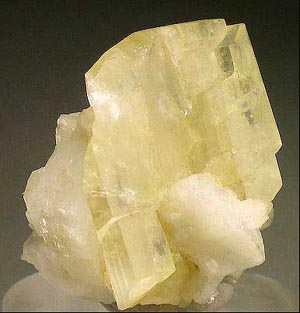
Minas Gerais, Brazil. Trinity Minerals specimen and photo.
The Costa Mesa Show took place on the weekend of May 15-17, and on that occasion John Veevaert picked up from Luiz Menezes a couple of specimen lots from new Brazilian discoveries. The pictures shown here are of John’s specimens, and you may see more on his Trinity Minerals site (www.trinityminerals.com), though you might also find their likes with Luiz (www.luizmenezes.com.br). First, some excellent specimens of montebrasite have lately come from the famous Telirio mine near Linópolis, Minas Gerais—best known for its fine brazilianite (in gemmy prismatic crystals distinctively different from blockier ones from the type locality, the Córrego Frio mine). Montebrasite is a Li-Na-Al phosphate which forms a series with amblygonite, and indeed many “amblygonite” specimens may really be montebrasite: the two are visually indistinguishable. These new specimens at their best show lustrous, transparent, palest yellow montebrasite crystals to 4 cm on matrix of well-crystallized, snow-white albite; other specimens offered on the Trinity Minerals site are loose, thumbnail-size single crystals of montebrasite.
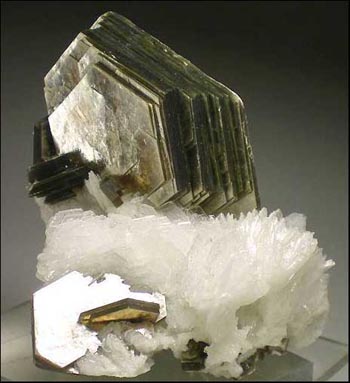
Brazil. Trinity Minerals specimen and photo.
Luiz Menezes also brought up from his headquarters in Belo Horizonte some radically attractive new specimens of muscovite from the Xanda mine at Virgem da Lapa, Minas Gerais. Very sharp muscovite “books” to more than 6 cm across perch on albite matrix in these miniature to cabinet-size specimens. The books are thick, showing many staggered “pages,” and they are lustrous and look very crisp, with a hard-to-describe color that is a combination of yellow, green, brown and silvery tones.
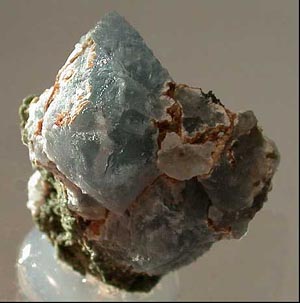
Giuseppe Siccardi specimen and photo.
Giuseppe Siccardi’s Your Mineral Collection site (www.yourmineralcollection.com) is lots of fun to surf through, especially if one wants a fun education in rare, or simply little-known, specimen-quality Italian minerals. On a recently posted “new from Italy” page, Giuseppe offers such things as perovskite from Val Susa; tinzenite and rhodonite from Val Graveglia; large clusters of very sharp orthoclase crystals from Sardinia; nice quartzes from various places in the Italian Alps; and—are we ready for this one?—pitiglianoite, a complex silicate-sulfate of the cancrinite-sodalite group, in glassy white, 6-mm crystals in volcanic rock, from Viterbo. This page also features a couple of matrix specimens showing fairly sharp, translucent, pale blue, octahedral crystals of haüyne to an exceptional 1.5 cm—among the largest crystals of haüyne ever found anywhere, and nearly a match for the best antique specimens of the species from Mte. Somma (Vesuvius), the type locality. (Shown in Part 4 of Rock Currier’s recent series of essays on mineral collecting is an old colored illustration of a haüyne crystal in matrix, probably from Vesuvius: see page 170 of March-April 2009). Giuseppe’s specimens are attributed to “Sacrofano, Campagnano, Roma,” although the locality designation can vary: a dealer’s price list from 1980 which I have at hand says that haüyne crystals are found in the nepheline and leucite-rich volcanic rocks of the Sacrofano quarry near Valle Biachella, Latium (near Rome). I repeat, these are monster-size crystals for the species, and they seem now to be trickling out: a few similar pieces appeared at the 2008 Munich Show.

Russia. Heliodor specimen and photo.
Brad and Star van Scriver of Heliodor (best web address to use: www.heliodor1.jodoshared.com) have come up with a few very large and beautiful quartz specimens from an old Russian locality: the Ushny quarry near Ushny village, Chelyabinsk Oblast, South Ural Mountains. The colorless, utterly transparent, loose quartz crystals reach 13 cm long. Many are doubly terminated but a few of the largest, unfortunately, have polished faces. Trust the van Scrivers, too, to have a few nice things from the contemporary-classic locality of Dalnegorsk, Primorskiy Kraj—which has lately been much more stingy in collector-quality specimens than it once was. This time the Heliodor site offers opaque but lustrous, pale amethystine quartz from the Bor quarry at Dalnegorsk, in single, sharp, stout crystals to 6 cm and loose groups to cabinet size; these specimens are from a pocket opened in summer 2006. And when I visited Brad and Star’s room at the Houston Show in early May I noticed that they still have about a dozen of those native platinum crystals from Konder, near Nelkan, Khabarovskiy Kraj, which had their debut at the 1993 Tucson Show (see the show report in vol. 24 no. 3, and see the locality article in vol. 28 no. 2). The cubic, metallic pale gray, slightly edge-rounded crystals reach 1 cm at most, and it must be mentioned that even the smaller ones sport four-figure prices, but according to Brad and Star it’s almost certain that no more Russian platinum crystals will ever reach Western markets. Native-element fans who as yet haven’t scored one of these world’s-finest platinum specimens may have to think about making their move right now.
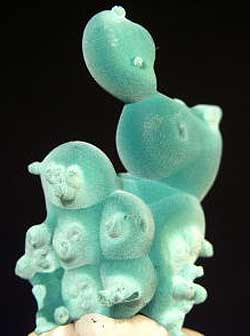
IC Minerals specimen and photo.
When, in 2003, I finished work on describing 117 mineral species from the famous Ojuela mine, Mapimí, Durango, Mexico—for our “Mexico II” issue on Ojuela (vol. 34 no. 5)—I thought that this great locality would thereafter have nothing new to offer in the way of collector-quality specimens. After all, mining at Ojuela, which was begun by the Spaniards in 1598, had by 2003 gotten down to desultory work by a handful of locals who were still employed by Mike New to hunt specimens, and nothing really “different” had come out for quite a long time. But during the latter part of this decade, thanks largely to new ore-mining by the Peñoles company in remote parts of the giant deposit, all sorts of colorful, exciting things have emerged, including distinctive-looking mimetite, austinite, copper-rich adamite, cerussite and, most abundantly, the finest wulfenite ever found in the mine (you can spot that wulfenite easily now, on the web and at shows, with dozens of dealers). Right now the Ojuela bounty is continuing with some beautiful specimens of rosasite: crusts, to large-cabinet size, of bright baby-blue rosasite botryoids associated with gleaming translucent white calcite crystals. Isaias Casanova of IC Minerals (www.icminerals.com) now offers a few such rosasite specimens, and what’s more he’s beginning to get in some Ojuela items including malachite, willemite (not listed as an Ojuela species in Moore and Megaw, 2003), austinite, copper-rich adamite and calcite enclosing aurichalcite. Two happy thoughts arise: (1) the Ojuela mine is far from “checked off” as a productive locality, and (2) Isaias has moved to Tucson, and will be conducting his mineral business from here, so I can easily check out his latest material, the better (of course) to keep all of you informed. Howdy, neighbor.
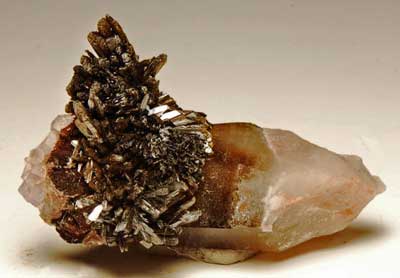
Batholith, Colorado. Lehigh Minerals specimen and photo.
A March 19 update on the site of Lehigh Minerals (www.lehighminerals.com) shows off some newly collected goethite specimens from the Crystal Peak area of the Pikes Peak Batholith, Park and Teller Counties, Colorado. Good goethite specimens from the microcline and smoky quartz-rich areas of the batholith have long been familiar, of course, but these new ones are very attractive, and larger than we are used to seeing. They show lustrous orange-brown, bladed to splintery goethite crystals aggregated in fanlike sprays to 7 cm, some fans and loosely attached groups of fans having come out loose, others resting on faces of milky quartz crystals.
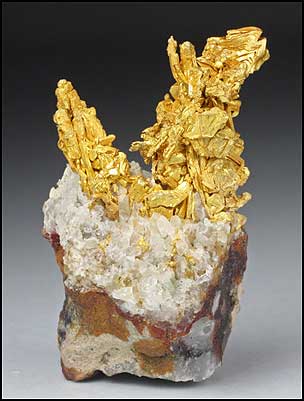
AA Rockshop specimen and photo.
Gold specimens from the Round Mountain mine, Nye County, Nevada have lately been visiting the market pretty regularly, thereby building the reputation of this locality as one of the world’s all-time best for well-crystallized gold (see Wendell Wilson’s article in the March-April 2009 issue). But most Round Mountain gold specimens we have seen so far are vein sections showing only gold, most commonly as flattened spinel-law-twinned crystals or as “herringbone” or dendritic aggregates; matrix specimens have been seen only rarely. Thus it’s noteworthy that Andrei Rykoff’s AA Rockshop (www.aarockshop.com) is offering a handful of Round Mountain specimens showing bright, branching groups of gold crystals rising from matrix of massive milky quartz. These well composed specimens range from 4 to 8.8 cm in maximum dimension. The gold crystals are largely of the familiar flattened-spinel-law-twin type, but there are also sharp cuboctahedrons to a few millimeters, and some crystals which clearly show the hopper growth habit.
Sharp-eyed Ibrahim Jameel of Khyber Minerals (www.khyberminerals.com) had a very good Tucson Show this year, picking up all sorts of unusual things of the “ever see that before?” kind, as well as good selections of more mainstream-type specimens. This is another profoundly educational/profoundly fun website to browse through, its “Tucson” and “post-Tucson” pages offering specimens of, for instance, bright orange drusy greenockite over miniature-size matrix plates from the Siglo XX mine, Bolivia; gemmy, dichroic crystals of lazulite from Laila Camp, Pakistan; sharp, lustrous, colorless crystals of euclase piled densely on matrix from near Dayu, Jiangxi, China; a little family of superb Brazilian xenotime thumbnails; Tsumeb rarities; and an extensive “Bolivian Sulfosalt” page where one finds very fine specimens of andorite, zinkenite and other metallic species from the San José mine, Oruro, Bolivia. The zinkenite is especially impressive, occurring as lustrous steel-gray, acicular crystals in bundles to 4 cm long, the best specimens consisting of several such bundles lightly attached. Other zinkenite specimens are simply delicate “nests” of acicular crystals, some showing a strong iridescence such that the nests shine fleetingly in oleaginous red-blue-green.
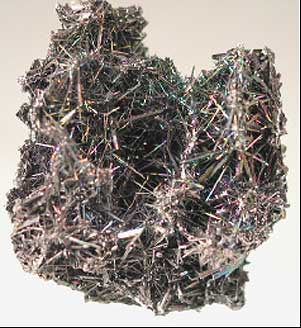
Khyber Minerals specimen and photo.
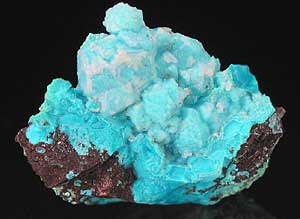
Baja California, Mexico. Khyber Minerals specimen and photo.
On another “Tucson Show” page of the Khyber Minerals site I was pleased to see some of the pretty specimens of chrysocolla pseudomorphous after boleite dug in January 2009 by Jack and Marty Crawford at an outcrop near the Amelia mine, Boleo, Mexico. I described these specimens (and there was a Jeff Scovil photo of one) in the HQLP (High Quality Low Price) section of my 2009 Tucson Show report (May-June 2009). Since writing that account I’ve observed, as has Ibrahim (as he says on his site), that these intriguing pseudomorphs have gone largely unmentioned by the various observers who publish their Tucson Experiences on the web. For prices that, frankly, no longer fit my HQLP rubric quite so well but that still don’t stray far into three-figure territory, Khyber offers thumbnail and miniature specimens that show distinct isometric forms, to a few millimeters, wholly replaced by bright baby-blue chrysocolla. There are also some larger specimens showing boleite and cumengeite crystals to a few millimeters embedded in friable-looking matrix of an earthy brown substance. Among the cumengeite crystals are sharp, blocky, opaque, pale blue, untwinned individuals to 7.5 mm.
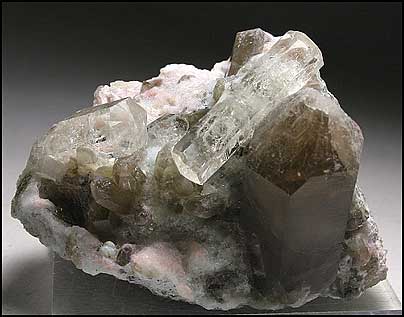
Mogok district, Burma. Demineralia specimen and photo.
In my published report on the 2009 Tucson Show I mentioned the fact that matrix specimens of phenakite from the Paleini mine, Khetchel village, Mogok district, Burma (Myanmar) are now at last appearing: until now we’ve seen this material almost exclusively as loose, transparent and colorless prisms broken off at one end and visibly “drill-bit-twinned” on the other. Emanuele Marini of Demineralia (www.demineralia.com) has just gotten in some large-miniature clusters of fairly sharp smoky quartz and K-feldspar crystals upon which rest pellucid, lustrous, “drill-bit” phenakite crystals to 3 cm, one of which is doubly terminated (see photo here).
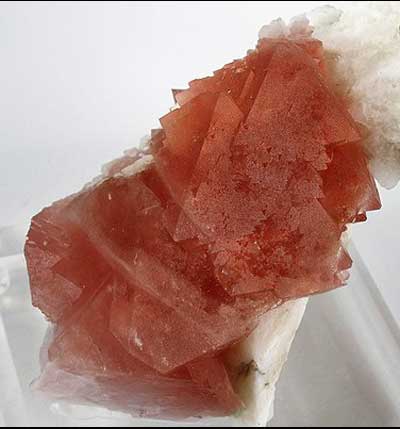
Haute-Savoie, France. The Arkenstone specimen and photo.
Ever-reliable Rob Lavinsky of The Arkenstone (www.irocks.com) nearly always puts in an appearance in these reports; this time he gets to wrap up the survey. Most interesting, I think, among the many premier-quality specimens new to his site are a very few marvelous pieces wherein sharp, transparent, octahedral crystals of pink fluorite to 4.5 cm are piled in rows upon pure white adularian orthoclase crystals, forming specimens which exceed 10 cm across. These are from a find in August 2007 on Aiguille Verte, one of the part-glaciated granite spires of the Mont Blanc massif near Chamonix, Haute-Savoie, France; Eric Asselborn vouches that this discovery was one of the very greatest of the myriad of pink fluorite discoveries made on Mont Blanc during the past two centuries or so. Do not expect specimens (Rob’s or anyone else’s) to be inexpensive, but their sheer beauty is hard to match anywhere else in the mineral kingdom.
Finally, Rob has another of those multi-page presentations of classics, oddities, unheard-of wonders, etc., which are such fun to scroll through—particularly, in this case, if one likes distinctive specimens from famous old eastern U.S. localities. Coming from three collections (Scalisi, Elling and Hollmann) recently acquired by Rob, the specimens on these six pages are mostly superb examples of, wow, pyromorphite from Phoenixville, Pennsylvania; pyrite from French Creek, Pennsylvania; chondrodite from the Tilly Foster mine, Brewster, New York; grossular and epidote from Eden Mills, Vermont; franklinite, rhodonite, phlogopite and rare species from Franklin and Sterling Hill, New Jersey…and more. Not so old as these, but so stunning as fairly to beg to be shown off here, is a cluster of the well known cubic (with slight tetrahexahedral modifications) magnetite crystals found in quantity during summer 1991 and spring 1992 in the Zinc Corporation of America #4 mine, Balmat, St. Lawrence County, New York. The late Ken Hollmann collected this 5.8-cm piece, which later went to the F. John Barlow collection; it is, I believe, the finest specimen of the material I have ever seen.
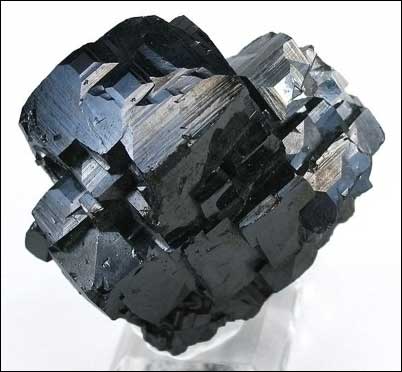
New York. The Arkenstone specimen and photo.
A New Museum; a New Show
In earlier reports I’ve mentioned some recent upbeat developments at my undergraduate Alma Mater, the University of Delaware, which acquired the fine mineral collection of Ireneé DuPont in 1965 (as a sophomore, I got to help then-curator Peter B. Leavens in unpacking and organizing the huge collection: my first real hands-on experience with serious mineral specimens). Since 1971 the DuPont Collection—as augmented expertly by Peter in those early days—has been exhibited in a small display room in Penny Hall, on the University of Delaware campus. Now a new curator, Sharon Fitzgerald, has taken over, and has just finished overseeing construction of a new display facility, also in Penny Hall. The university’s Mineralogical Museum had its grand opening on May 2, 2009, and will from now on be wowing the public with its superb worldwide minerals, plus special displays on topics including gem crystals, pseudomorphs, Mexican/South American minerals, minerals from Pennsylvania and Delaware, temporary exhibits (the first is of copper specimens from Michigan), and “visiting” collectors’ exhibits (the first, contributed by longtime donor David A. Byers, features a Sweet Home mine specimen called the “Alma Jack” rhodochrosite). Perhaps the best news of all is that from now on the collection’s growth will be accelerating, thanks to the generosity of private donors as well as to more generous funding by the university than heretofore. The Museum’s hours are posted on www.udel.edu/museums, and a visit is (of course) highly recommended.
The July-August 2009 issue of the Mineralogical Record contains my report on Dave Waisman’s new Houston Show, which took place during the first days of May, 2009, succeeding Dave’s May 2008 Dallas Show. Well, Dave would like everybody to know that he’s been organizing another new show as well, this one in—San Francisco! Yes, the inaugural San Francisco Fine Mineral Show will take place on the weekend of July 10-12, and will feature Dave’s usual company of first-rate dealers, including many we’re used to seeing at the Westward Look (Tucson) and Houston Shows. The venue will be the Embassy Suites Hotel, 101 McInnis Parkway—not precisely in San Francisco, but across the Golden Gate bridge, in San Rafael. Admission and parking are free. Let us salute Dave for his persistence in staging these small, sophisticated-yet-casual events all around the West in the summertime, i.e. during the normally torporific gap between Tucson and Denver.
JUNE 4 UPDATE: In the days just after posting the report above I’ve had word (from more than one excited correspondent) of a record-breaking new quartz specimen which has been unearthed at Petersen Mountain, Washoe County, Nevada. This locality—which has also gone by the names “Hallelujah Junction” and “Kristal Tips mine”—lies on the Nevada/California border about 25 miles north-northwest of Reno. For at least a couple of decades now, cavities in thick milky quartz veins in the granodiorite of Petersen Mountain have produced sceptered quartz crystals, some smoky, some amethystine, a few even citrine, and many quite large…but spice up your summer day, now, by checking out THIS one. I have no information about ownership, but for sending me the photo I heartily thank Richard Geiger.
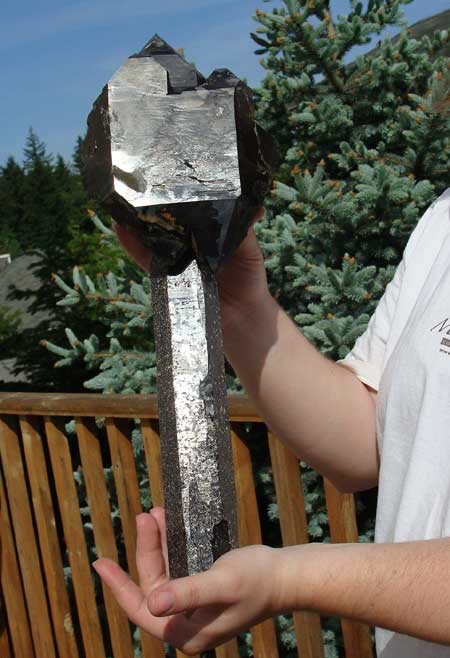
So long, then, until later in the Torpor….
For questions about this column, please email Tom Moore.
